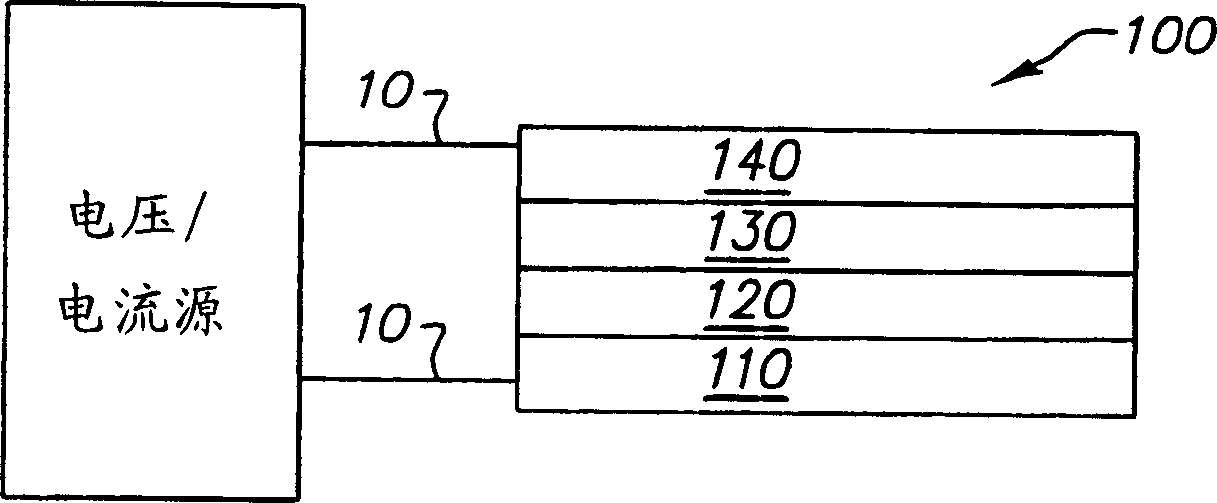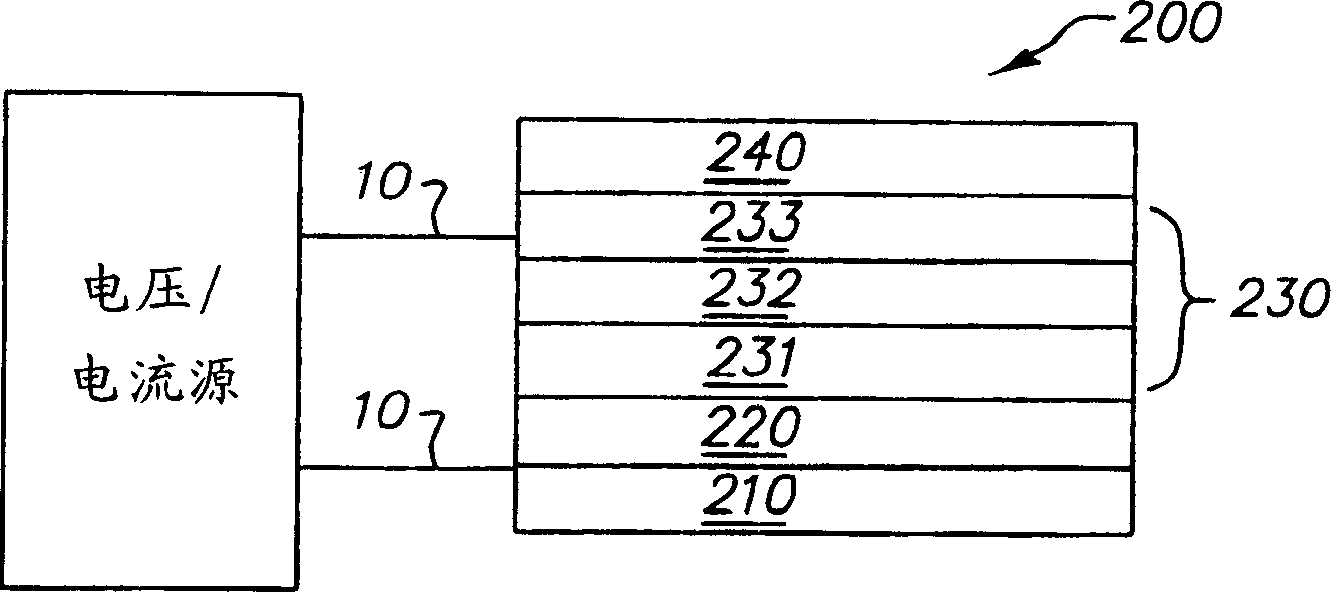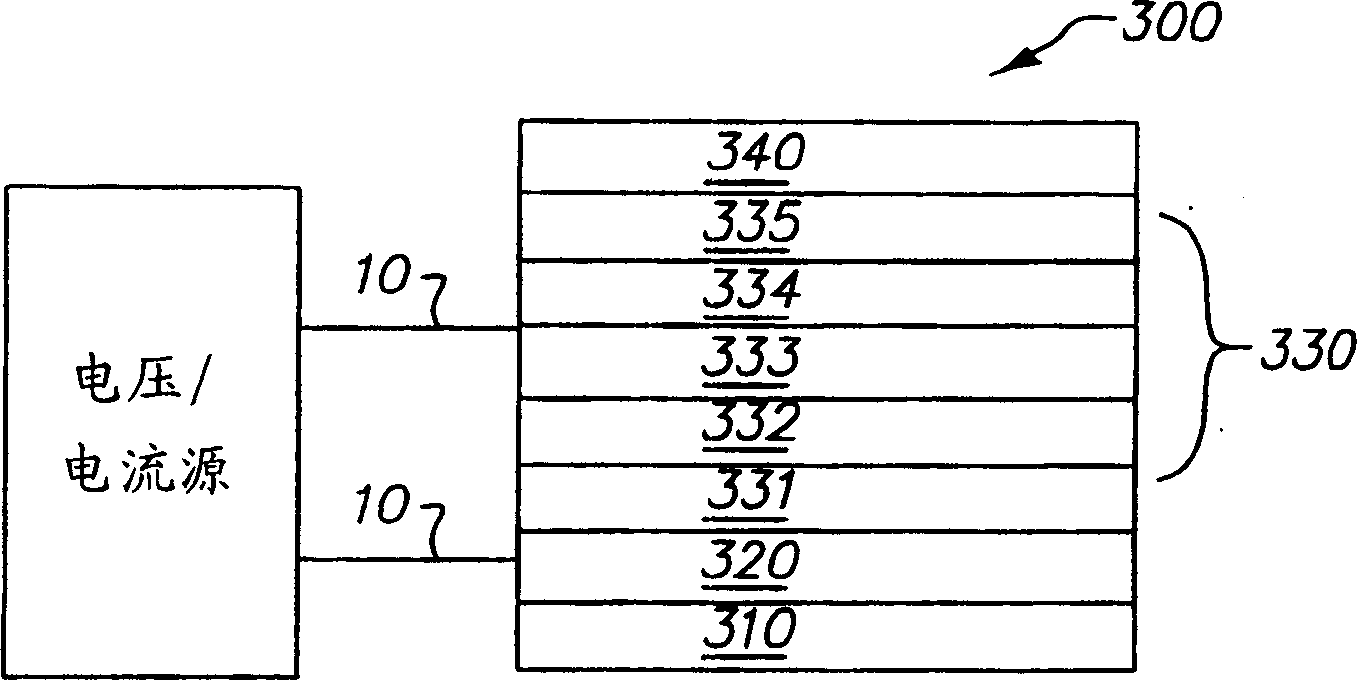Organic light-emitting diode equipment with improved operation stability
A technology of organic light-emitting devices and light-emitting layers, which is applied in the direction of light-emitting materials, electroluminescence light sources, organic semiconductor devices, etc., can solve the problems of low working stability and insufficient stability, and achieve outstanding luminous efficiency and color chroma, high Operational stability, long life effect
- Summary
- Abstract
- Description
- Claims
- Application Information
AI Technical Summary
Problems solved by technology
Method used
Image
Examples
Embodiment 2-6
[0152] OLED devices 2-6 were constructed similarly to Comparative Example 1, except that naphtho[2,3-a]pyrene was used as the first host material and AlQ was used as the second host material in the emissive layer (2). The relative content of naphtho[2,3-a]pyrene and AlQ based on volume is 1:99, 2:98, 4:96, 10:90 and 15 for Examples 2, 3, 4, 5 and 6, respectively. : 85. The EL characteristics of devices 2-6 are listed in Table I. As can be seen from Table I, devices 2-6 show that as the volume % of naphtho[2,3-a]pyrene increases: 1) the luminous efficiency decreases slightly and then increases; 2) the emission color shifts from green to yellow Green; 3) Variation of Δcd / A versus J from gain to larger loss then smaller loss; 4) 200-800% improvement in lifetime relative to control device 1 . Comparative Example 7
Embodiment 8-11
[0155] OLED devices 8-11 were constructed similarly to Comparative Example 7, except that the light-emitting layer was prepared using naphtho[2,3-a]pyrene as the first host material, AlQ as the second host material, and CFDMQA as the dopant . Naphthalene[2,3-a]pyrene, AlQ and CFDMQA are based on the relative content of volume ratio for embodiment 8,9,10 and 11 are respectively 1:98.5:0.5, 2:97.5:0.5,4:95.5:0.5 and 8:91.5:0.5. The EL characteristics of devices 8-11 are listed in Table I. As can be seen from Table I, devices 8-11 show that as the volume % of naphtho[2,3-a]pyrene increases: 1) the luminous efficiency drops by about 40%; 2) the emission color shifts from green to yellow-green 3) Change in Δcd / A versus J from gain to loss; 4) 240-550% improvement in lifetime over control device 7. Comparative Example 12
Embodiment 13-16
[0158] OLED devices 13-16 were constructed similarly to Comparative Example 12, except that the light-emitting layer was prepared using naphtho[2,3-a]pyrene as the first host material, AlQ as the second host material, and C545T as the dopant . Naphthalene[2,3-a]pyrene, AlQ and C545T are based on volume ratio relative content for embodiment 13,14,15 and 16 are respectively 1:98.5:0.5,2:97.5:0.5,4:95.5:0.5 and 8:91.5:0.5. The EL characteristics of devices 13-16 are listed in Table I. As can be seen from Table I, devices 13-16 show that as the volume % of naphtho[2,3-a]pyrene increases: 1) the luminous efficiency drops by about 45%; 2) there is no significant shift in the emission color; 3 ) change in Δcd / A vs. J from no loss to loss; 4) 340-1000% improvement in lifetime over control device 12 . also measured at 20mA / cm 2 and T under RT 50% : Example 12 is 1600h and Example 16 is 14200h.
[0159] Example
[0160]OLED device 17 was constructed similarly to Comparat...
PUM
| Property | Measurement | Unit |
|---|---|---|
| thickness | aaaaa | aaaaa |
Abstract
Description
Claims
Application Information
 Login to View More
Login to View More - R&D
- Intellectual Property
- Life Sciences
- Materials
- Tech Scout
- Unparalleled Data Quality
- Higher Quality Content
- 60% Fewer Hallucinations
Browse by: Latest US Patents, China's latest patents, Technical Efficacy Thesaurus, Application Domain, Technology Topic, Popular Technical Reports.
© 2025 PatSnap. All rights reserved.Legal|Privacy policy|Modern Slavery Act Transparency Statement|Sitemap|About US| Contact US: help@patsnap.com



